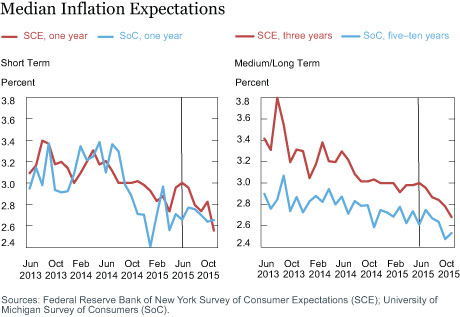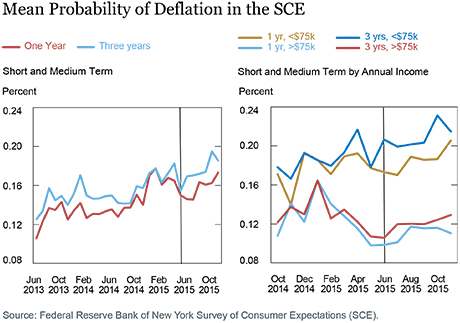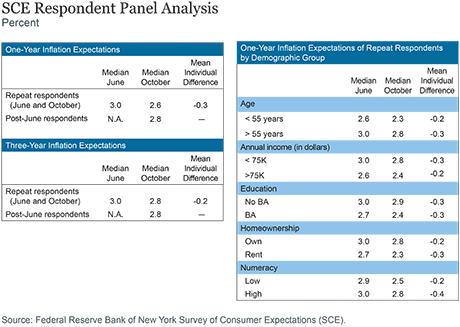Correction: In the right panel of the chart, “Mean Probability of Deflation in the SCE,” we have corrected the labels for the group earning less than $75k, which were initially transposed. We regret the error.
The expectations of U.S. consumers about inflation have declined to record lows over the past several months. That is the finding of two leading surveys, the Federal Reserve Bank of New York’s Survey of Consumer Expectations (SCE) and the University of Michigan’s Survey of Consumers (SoC). In this post, we examine whether this decline is broad-based or whether it is driven by specific demographic groups.
The SCE is a two-and-a-half-year-old monthly survey of heads of U.S. households and differs from the SoC in several respects:
- The SCE focuses primarily on expectations about economic outcomes related to inflation, the labor market, and household finance.
- The SCE relies upon a larger sample of respondents (about 1,300 monthly versus about 500 for the SoC). It also uses a rotating panel (each month the SCE adds around 170 new respondents who stay in the panel for up to twelve consecutive months before rotating out).
- The surveys also differ with respect to the way a respondent’s inflation expectations are elicited. The SCE asks directly about the “rate of inflation,” which seems to provide more reliable responses. Perhaps more importantly, the SCE not only elicits a traditional point forecast for what a respondent thinks future inflation will be, but also elicits the full belief-distribution of respondents by asking them to assign probabilities to different ranges for future inflation outcomes.
- Although both surveys ask respondents for their inflation expectations for the same short-term horizon (one year), the SCE asks about a specific medium-term horizon (three years), while the SoC asks about a less clearly defined long-term horizon (five to ten years).
Despite these differences, the same pattern has been observed recently in the two surveys: As indicated in the chart below, the median inflation expectations at the short-term and at the medium-/long-term horizons have been declining relatively steadily in both surveys. If we focus on 2015, we see that after a relatively stable period, inflation expectations at the three-year horizon (and to a lesser extent, at the one-year horizon) have declined sharply starting around the beginning of the summer. In fact, inflation expectations have recently declined to record levels in both surveys. In October 2015, the SoC median expectation for long-term inflation tied the lowest level ever recorded (2.5 percent) since the SoC started collecting monthly data. Inflation expectations in the SCE, which has a much shorter time series, have also declined to record levels over the past couple of months—both at the short- and the medium-term horizons. In fact, the November 2015 level at the one-year horizon (2.55 percent) was not only a series low, but it was also the largest one-month drop recorded since the inception of the SCE in July 2013.

To establish whether the recent decrease in inflation expectations observed in the above chart may be attributed to a specific segment of the population, we partitioned the survey respondents into different demographic groups, including by age, income, education, homeownership, the region in which the respondent resides, employment status, and even, in the case of the SCE, a measure of the respondent’s numeracy skills.
Overall, our analysis reveals that the decrease in short- and medium-/long-term inflation expectations is fairly broad-based in both surveys. For instance, the chart above plots median short-term inflation expectations by educational attainment (left panel), and median medium-/long-term inflation expectations by income (right panel). We identify similar patterns in both surveys. In particular, respondents with lower education and respondents with lower income generally have higher median inflation expectations. However, there is no clear evidence that the recent decrease in inflation expectations is driven primarily by a specific income or education group. Nevertheless, the right panel of the above chart illustrates that medium- to long-term inflation expectations continued to decline among higher income respondents in the latest SCE and SoC surveys. That is in contrast to the medium- to long-term expectations of lower income respondents, which have rebounded in both surveys. It will be interesting to see if this phenomenon persists in coming months.

Now, using data from the SCE, we look at the issue from a different angle: Because an inflation density forecast is elicited for every respondent in the SCE, we can calculate the probability each assigns to the event that inflation will be negative (in other words, deflation). In the left panel of the chart below we plot the mean probability of deflation across SCE respondents for the one-year and the three-year horizons. Consistent with what we observed earlier, there has been an increase in the probability of deflation at both horizons starting around the beginning of the summer 2015.
Again, breaking down the data by demographic groups reveals no differential patterns. Thus, the increase in the probability of deflation seems fairly broad-based. This result is illustrated in the right panel of the chart below where we plot the probability of deflation by income levels. While lower income respondents systematically assign a higher probability to the possibility of deflation, the probability of deflation has generally increased in recent months for both income groups. In fact, we do not show this in a chart, but the entire distribution of inflation expectations—including the median and 75th percentile—has shifted downward over the last several months at both the one- and three-year horizons.

Finally, we exploit the panel structure of the SCE to analyze the decline in inflation expectations at the individual level, that is, for the same respondent. Recall that an SCE respondent completes the survey for up to twelve consecutive months. Thus, the respondents who completed the SCE in October 2015 may be partitioned into two groups: the group of respondents who completed the SCE survey both in June and in October 2015, and the group of respondents who entered the SCE panel after June 2015 (and thus completed the October 2015 survey, but not the June survey).
For the first group, we can compare the inflation expectations an individual reported in June with the inflation expectations that same person reported in October. As indicated in the left panel of the chart below this group of “repeat” respondents reported lower median inflation expectations in October than in June, both at the one-year and three-year horizon. In fact, the difference in reported inflation expectations by a given respondent between October and June 2015 was on average -0.3 percent and -0.2 percent at the short- and long-term horizons, respectively.

Now, what about the second group of respondents who entered into the SCE panel after June 2015? We can see in the table above that their median expectations in October 2015 were similar to the median expectations of the other group in October 2015, but smaller than the expectations reported by the repeat respondents in the other group in June 2015. Thus, we not only find evidence of a decrease in inflation expectations at the individual level, but we also find no clear evidence of a composition effect, whereby the cohort of respondents who entered the SCE panel after June 2015 had different expectations in October 2015 than the respondents who were already part of the SCE panel in June 2015. Is the individual decline in expectations we just documented driven by a specific demographic group? In the right panel of the table above we report the difference in a given respondent’s expectations between June and October 2015 for various demographic groups. Although there are small differences across groups, the difference is negative for all groups, and the difference is not substantial across groups. This panel analysis therefore reinforces our previous conclusion that the recent decline in inflation expectations is fairly homogenous across demographic groups.
Disclaimer
The views expressed in this post are those of the authors and do not necessarily reflect the position of the Federal Reserve Bank of New York or the Federal Reserve System. Any errors or omissions are the responsibility of the authors.

Olivier Armantier is an assistant vice president in the Federal Reserve Bank of New York’s Research and Statistics Group.

Wilbert van der Klaauw is a senior vice president in the Bank’s Research and Statistics Group.

Giorgio Topa is a vice president in the Bank’s Research and Statistics Group.

Basit Zafar is a research officer in the Bank’s Research and Statistics Group.










 RSS Feed
RSS Feed Follow Liberty Street Economics
Follow Liberty Street Economics